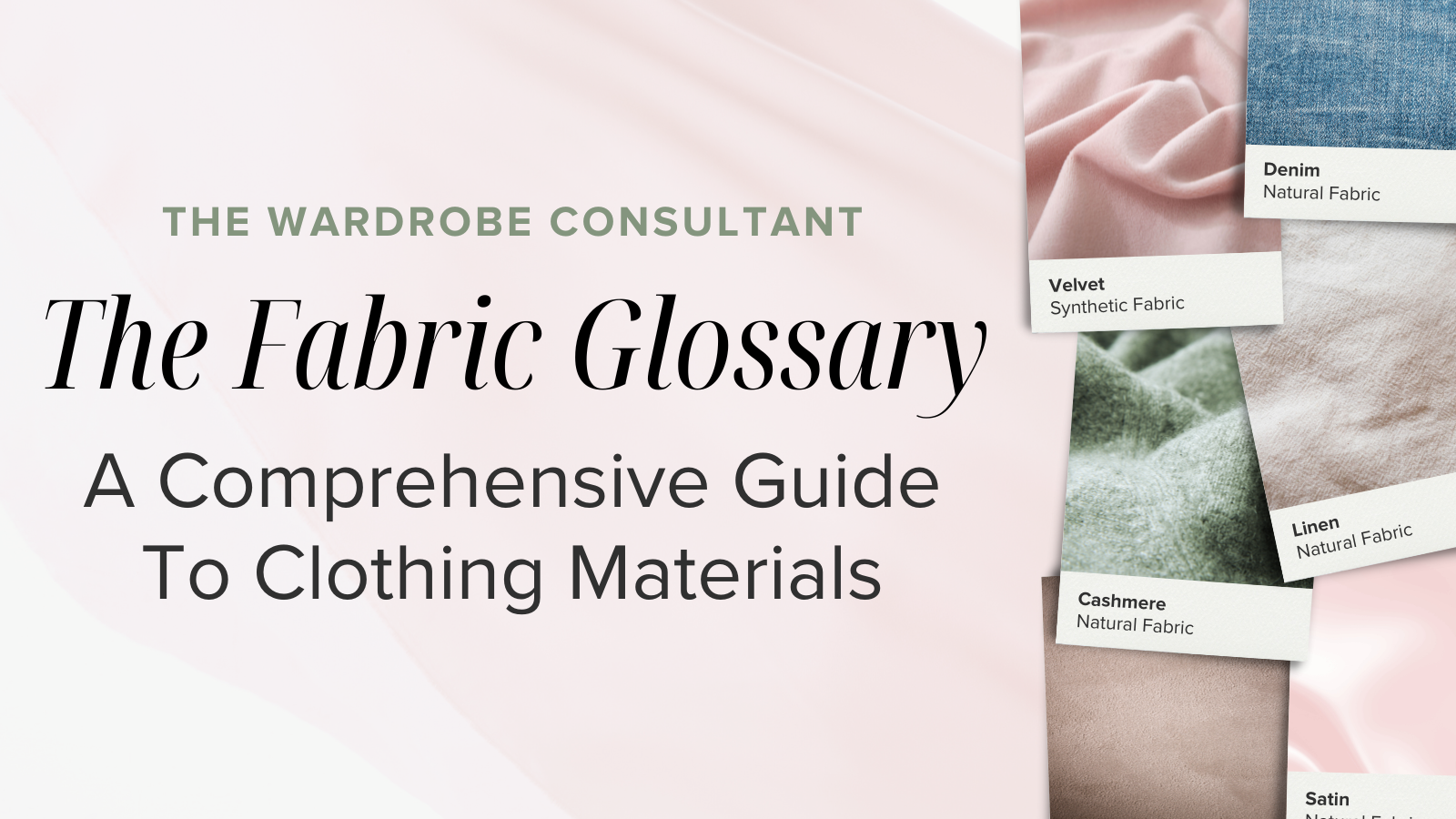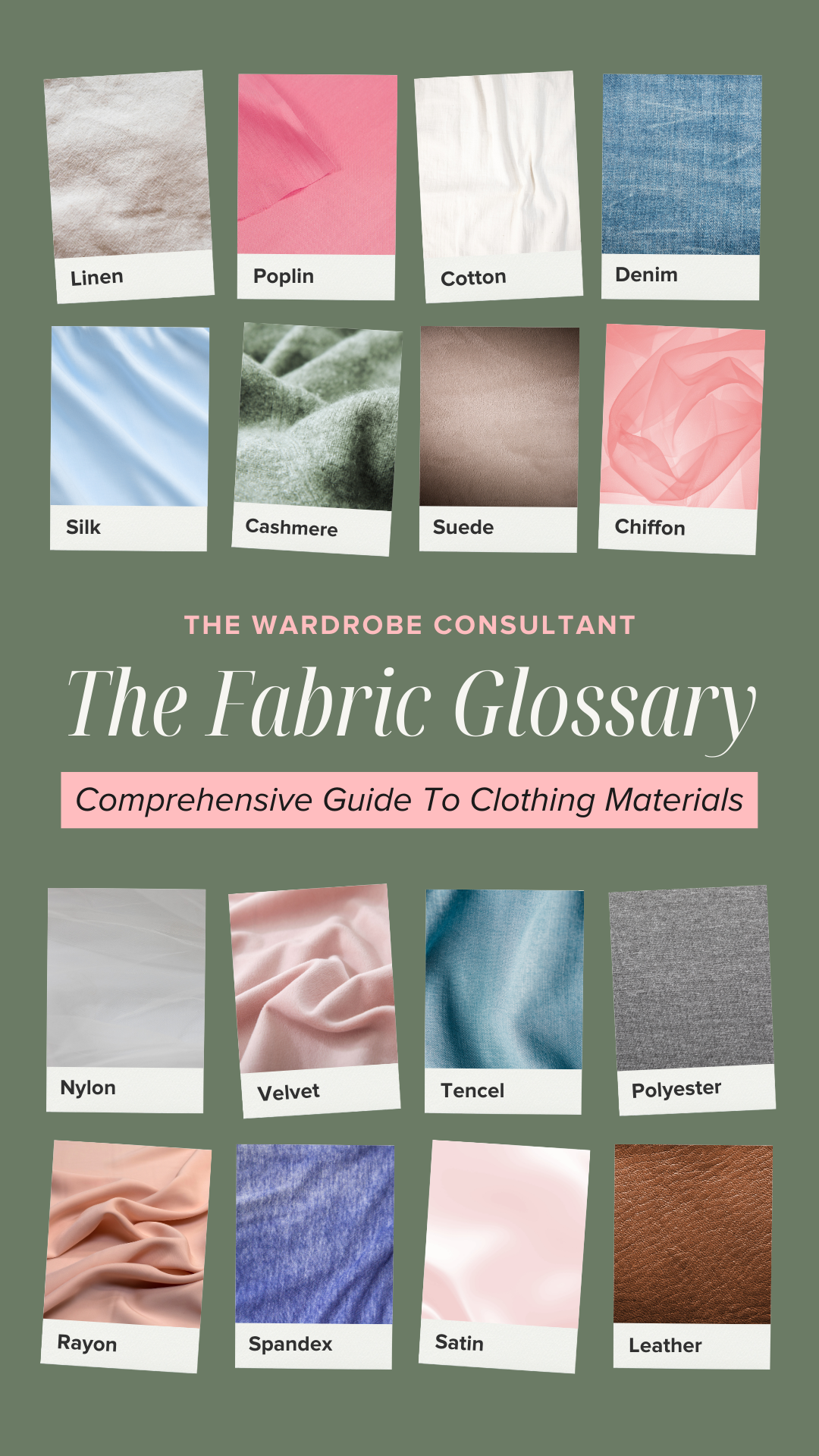The Fabric Glossary: Comprehensive Guide To Clothing Materials
You know that saying, it’s what’s on the inside that counts? Well…when we’re talking about fashion and clothing it really is true. It’s not just about the cut, design, or color of a garment. One of the foundational elements of any piece of clothing is the fabric it's made from. Understanding fabrics can empower your choices about what you wear and how it will ultimately make you feel when wearing it. Let’s unravel the world of fabrics and materials!
We hear about various fabrics and maybe even have looked at a label here and there. But do you REALLY know what the different materials are and what they even mean? Natural vs synthetic vs blends? And which ones wrinkle? And which materials keep you cool? Or warm? Which ones can be washed at home and which need to be dry-cleaned?
Understanding Fabrics
This post really came about because linen has been so prominent in fashion this summer and I received many, many questions and IG comments asking “is it okay to wear linen wrinkled? Or do I need to iron it?” Personally. I like when fabrics show their personality - the linen gets a bit wrinkled, the denim gets worn in and whiskers etc. It is perfectly imperfect and adds interest and a bit of effortlessness to a look. That being said, you have to know your personal threshold for “imperfection”.
Consider this your crib notes on all things clothing fabrics.
Please note: there are so many more fabrics than I’ve covered here. As well as various blends of both natural and synthetic materials. I’ve covered the bigger ones that I feel are most used. There are also subsets such as organic or recycled products that may play into your choice from a sustainability and environmental perspective.
Natural Fabrics
Nature has blessed us with a plethora of fibers that have been spun into some of the most beloved fabrics in the fashion industry. These fibers are derived directly from nature, making them both sustainable and often more biodegradable than synthetic counterparts.
Cotton
Origin and Production: Cotton, sourced from the fluffy seed pods of the cotton plant, has graced human clothing for over 7,000 years. Major producers today include countries like India, China, and the USA.
Characteristics: Cotton stands out for its breathability, soft texture, and moisture-wicking properties. Its durability allows it to withstand high temperatures and repeated washings.
Styling Tips: Given its versatility, cotton is the go-to for t-shirts, summer dresses, jeans, and even underwear. It's ideal for everyday wear and especially comfortable in warmer climates.
Care: Cotton can generally be machine-washed. However, it's prone to shrinking and can wrinkle easily. Using cold water and air-drying can help mitigate these issues.
Denim
Origin and Production: Originating in Nîmes, France (hence the name "de Nîmes" or "from Nîmes"), denim is a sturdy cotton warp-faced textile known for its use in jeans. It’s created by passing the weft under two or more warp threads, which gives it its characteristic diagonal ribbing.
Characteristics: Denim is durable, versatile, and over time, forms to the body's shape, making worn-in jeans feel tailor-made.
Styling Tips: Beyond classic jeans, denim is popular for jackets, tops, skirts, and even accessories. It can be dressed up with heels or kept casual with sneakers.
Care: Wash inside out in cold water to preserve color. Air drying is best to retain fit and prolong lifespan.
See also:
Linen
Origin: Derived from the stems of the flax plant, linen is one of the oldest known textiles, tracing back to ancient Egypt.
Characteristics: Linen is celebrated for its lightweight and breathable nature. Because of this it’s typically a warm weather fabric. Its natural luster gives it a distinct, rich appearance. However, it's also known to wrinkle quickly.
Styling Tips: Linen exudes a casual, laid-back elegance, making it perfect for summer dresses, shirts, and trousers. Its cooling properties make it a favorite for tropical climates.
Care: Linen garments are best hand-washed or machine-washed in cold water on gentle cycles. They should be air-dried and can be ironed while slightly damp for best results.
100% Linen Dress
Silk
Origin: A luxurious fabric, silk is produced by silkworms, primarily the larvae of the mulberry silk moth. Historically associated with the Silk Road, it has been a symbol of opulence for centuries.
Characteristics: Renowned for its shimmering appearance, silk has a smooth touch and drapes beautifully. It's lightweight and can be warm in winter and cool in summer.
Styling Tips: Silk's elegance makes it a top choice for evening wear, blouses, lingerie, and scarves. It pairs well with accessories like pearls and diamonds to create a sophisticated look.
Care: Silk is delicate. It's recommended to dry-clean silk garments. If hand-washing, use cold water and mild detergent, avoiding wringing. Always air-dry away from direct sunlight.
Wool
Origin and Production: Sourced from the fleece of sheep, wool has been used in clothing for millennia. Regions with cooler climates, like Australia and New Zealand, are major wool producers.
Types: From the soft and plush cashmere (from goats) to the fine Merino, wool comes in various grades and types.
Characteristics: Wool is naturally insulating, making it a winter favorite. It's also moisture-wicking and can repel small amounts of water. Some wool is quite itchy, while other forms are not. Personal preference and sensitivity can factor into an individual's ability to wear certain types of wool.
Styling Tips: Wool is synonymous with cozy winter wear. From thick cardigans to elegant pea coats and scarves, wool adds warmth without compromising style.
Care: Wool garments can last years with proper care. It's best to hand-wash them in cold water with gentle detergents. Flat drying is recommended to maintain the garment's shape.
Cashmere
Origin and Production: Cashmere is a testament to the fact that not all wools are created equal. Cashmere is a luxury natural fiber obtained from the soft undercoat of cashmere goats, primarily found in the mountainous regions of Mongolia, China, and India. These goats produce a double fleece consisting of a coarse outer coat and a fine, soft undercoat. The latter is what's used to produce cashmere wool.
Characteristics: Cashmere is renowned for its softness, warmth, and lightweight properties. It provides superior insulation without the bulkiness of many other wools. This fine fiber has a smooth texture that, unlike sheep's wool, is not prickly and is more comfortable against the skin.
Styling Tips: Due to its luxurious feel and look, cashmere is often used in high-end sweaters, scarves, and wraps. Its classic and timeless appeal makes it perfect for both casual and formal wear. A well-maintained cashmere sweater can be a staple piece in one's wardrobe for years.
Care: Cashmere requires gentle care. Hand washing in cold water with a mild detergent is recommended. To dry, lay the garment flat on a towel, reshaping it to prevent stretching. Avoid hanging, as this can distort the shape of the garment.
Leather
Origin and Production: Leather is a natural material derived from the hide of animals, primarily cattle. After the skin is removed, it undergoes a tanning process to produce a flexible, durable material.
Characteristics: Known for its durability and timeless appeal, leather is both robust and flexible. Over time, it can develop a unique patina that many find aesthetically appealing.
Styling Tips: From classic leather jackets to pants, boots, belts, and handbags, leather offers a rugged yet sophisticated touch to any ensemble. It's a staple in both casual and luxurious fashion.
Care: Regularly clean with a damp cloth and occasionally condition to maintain its suppleness and shine. Store in a cool, dry place away from direct sunlight.
See also:
Suede
Origin and Production: Suede is made from the underside of animal skin, often from lamb, though goat, calf, and deer are also used. This makes it softer and more pliable than standard leather but also less durable.
Characteristics: Recognized for its soft, napped finish, suede provides a velvety touch, adding warmth, texture and interest.
Styling Tips: Commonly used in footwear, jackets, gloves, and handbags. Its texture adds depth to outfits and is frequently associated with fall and winter fashion. Although, suede can absolutely be worn year round.
Care: Use a suede brush to clean and revitalize the nap. Protect from moisture and stains using a suede protector spray.
See also:
Chiffon
Origin and Production: From the French word for a cloth or rag, chiffon is a lightweight fabric made from cotton, silk, or synthetic fibers.
Characteristics: Chiffon is sheer, with a slight rough feel. Its light texture and translucent nature make it a popular choice for gowns, scarves, and blouses.
Styling Tips: Due to its delicate nature, chiffon is often seen in evening wear and special occasion dresses. It layers well and adds a touch of elegance to any outfit.
Care: Hand washing in cold water with mild soap is recommended. If machine washing, use a mesh bag and a gentle cycle. Drip dry to avoid shrinkage and maintain texture.
Twill
Origin and Production: Twill refers to a type of textile weave with a pattern of diagonal parallel ribs. It can be made from any fiber, but common ones include cotton and wool.
Characteristics: Twill drapes well and is resistant to wrinkles and stains. It's identified by the visible diagonal lines on its surface.
Styling Tips: From denim jeans to chino pants and jackets, twill's resilience and texture make it a popular choice for various garments.
Care: Generally machine washable. The care largely depends on the fiber used, so always check the garment's label.
Tweed
Origin and Production: Originating from Scotland, tweed is a rough, woolen fabric known for its signature mixed color effect.
Characteristics: Thick and warm, tweed is often woven with a herringbone structure and is recognized for its durability.
Styling Tips: Iconic for winter wear, especially in outerwear, suits, and hats. Its rustic appearance makes it ideal for countryside chic and vintage-inspired looks.
Care: Dry cleaning is preferred due to its wool composition. Avoid washing frequently to maintain its structure.
Poplin
Origin and Production: Originating from the French word "papeline," poplin is a plain weave fabric made using fine, crosswise ribs. Traditionally made from silk and wool, modern poplin is often made with cotton or polyester.
Characteristics: Lightweight with a smooth surface, poplin is crisp and resists wrinkles.
Styling Tips: A staple for summer clothing, poplin is commonly used in shirts, dresses, and skirts, offering a neat, polished look.
Care: Machine washable in cool water. Iron while damp on the reverse side to maintain its crisp appearance.
Natural fabrics are not just a nod to the past but a significant player in future fashion, especially in the realm of sustainability. Each fabric, with its unique origin and attributes, offers a myriad of styling opportunities.
Synthetic Fabrics
Polyester
Origin and Production: Polyester, born out of the chemical reactions involving coal, air, water, and petroleum, burst onto the fashion scene in the 20th century.
Characteristics: Known for its exceptional durability, wrinkle resistance, and ability to retain shape, polyester also dries quickly. Polyester gets sort of a bad rap from the 1970’s leisure suits, but the fabric has come a long way.
Styling Tips: Its versatility finds it in various garments – from casual tops to evening wear and sportswear.
Care: Polyester is machine-friendly and doesn’t shrink easily. However, it's advisable to wash in cool water and avoid over-drying, which can cause the fabric to pill.
Nylon
Origin: Introduced in the 1930s, nylon was initially promoted as an artificial silk replacement.
Characteristics: Nylon is praised for its strength while being exceptionally lightweight. It’s also resistant to both moisture and mildew.
Styling Tips: Owing to its elasticity, nylon often finds its way into activewear, swimwear, and stockings.
Care: Nylon garments should be washed in cold water. To prevent static clinging and maintain the fabric's integrity, air drying is recommended.
Rayon
Origin: Although semi-synthetic, rayon is worth mentioning. Made from wood pulp, it was developed as an alternative to silk and cotton.
Characteristics: Rayon drapes beautifully and is highly absorbent, often feeling cooler than cotton.
Styling Tips: Its soft, smooth texture is perfect for summer dresses, blouses, and scarves.
Care: Rayon can shrink when washed, so hand washing or dry cleaning is often recommended. If machine washing, use cold water on a gentle cycle.
Satin
Origin and Production: Originally made from silk, satin refers more to the weave of the fabric than the material itself. Today, it can be made from various materials, including polyester.
Characteristics: Satin is known for its glossy surface and a dull back. Its smooth, shiny face comes from the weave pattern, which minimizes the interruptions of the yarn on the surface.
Styling Tips: Its luxurious sheen makes satin a favorite for evening gowns, lingerie, and wedding attire. However, it can also add elegance to everyday outfits when incorporated into blouses or accessories.
Care: Hand wash or machine wash on a gentle cycle with cold water. Avoid wringing, and air dry away from direct sunlight to preserve the sheen.
Spandex
Origin and Production: Spandex is a synthetic fiber known for its exceptional elasticity. It was invented in 1958 by chemist Joseph Shivers at DuPont's Benger Laboratory in Waynesboro, Virginia.
Characteristics: Spandex is stronger and more durable than natural rubber, and it can be stretched over 500% without breaking and then return to its original length. This elasticity makes it a key ingredient in many form-fitting garments.
Styling Tips: Often incorporated into athletic wear, swimwear, and undergarments for its stretchability. Also found in casual wear and fashion garments to provide a more body-hugging fit.
Care: Avoid high temperatures when washing and drying as heat can damage the elastic fibers. Preferably, use cold water for washing and air dry. Avoid chlorine bleach, as it can weaken the spandex fibers.
Velvet
Origin and Production: With roots in the Middle Ages, velvet was once a luxury material made from silk, and reserved for royalty. It's woven on a special loom that weaves two thicknesses of material at the same time, which are then cut apart. Today most velvets are made from synthetic fibers such as rayon, polyester and viscose.
Characteristics: Velvet is known for its soft texture and sheen, which results from the short, dense pile on its surface.
Styling Tips: Ideal for evening wear, holiday dresses, and luxurious accessories. In recent fashion, velvet has also made its way into casual wear like tops and shoes.
Care: Dry cleaning is preferred due to the fabric's delicate nature. If machine washing, use a gentle cycle and avoid wringing.
Tencel
Origin and Production: Tencel is a branded name for lyocell, a fiber made from sustainably sourced wood pulp, primarily from eucalyptus, spruce, and pine. Tencel is eco-friendly and produced in a closed-loop process.
Characteristics: Tencel is silky, breathable, and moisture-wicking, with excellent durability and biodegradability.
Styling Tips: Suitable for a range of garments, its natural drape and sheen make it versatile for both casual and formal looks, as well as vibrant patterns.
Care: Machine-washable on a cold, gentle cycle; avoid bleach and preferably air-dry, although low tumble-drying is generally acceptable; iron at low temperatures.
Synthetic fabrics have revolutionized the fashion industry, introducing resilience, affordability, and specific functionalities to our clothing choices. As technology continues to evolve, we can expect even more innovative materials with tailored properties to emerge. While they might not always carry the eco-friendly badge, advancements in recycling and sustainable production are bridging this gap, making synthetic fabrics a dynamic player in the ever-evolving world of fashion.
Knowing what your garments are made of can help you find pieces that best suit your lifestyle. Taking a fabric-first approach is just another way of building a wardrobe you love that is specifically tailored to you.
































